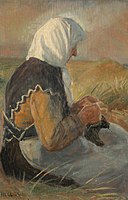I am knitting socks for my dad for Christmas – plain and simple socks, using some of my stash of fingering weight yarn, made of the usual blend for sock yarn ( 25 % nylon, 75 % superwash merino wool). I am NOT enjoying it. As I knit, I am ruminating on all the pollution that was caused during its processing, particularly the creation of persistent organic pollutants through the chlorination of the superwash merino. These pollutants will still be there decades after his death and mine! The damage can’t be unraveled, so here I go, knitting my dad a pair of socks.
Last year, I knitted him socks, and I was thrilled throughout. I was using Norwegian wool for the first time, experimenting with colorwork, changing the design to fit his feet, etc. I was thrilled. This year, there is no colorwork, no interesting Norwegian wool. Fact is, he hardly wore the pair I knitted him last year; they are too warm. They’d be fine if he were still cross-country skiing or if we were in the ’80s and he was still walking to his job each day. Those days are gone; he is in HIS eighties, and the climate is considerably warmer. Hence plain socks it is. And I am bored.
So, between my ruminations about the wool industry and how I fell for all its greenwashing, it dawned on me that this is the kind of knitting people used to have to do.

Stockinette stitch comes from stocking and that was the garment item so many people spent hours and hours knitting. On – as far as we know – very thin needles (less than 2.5 mm) and on and on and on. How long does knitting a pair of stockings take ; 3 or 4 more times longer than knitting a pair of socks ? More? Spinning the wool, then knitting the sock (or most likely stocking), washing it, darning it, patching it, reknitting the heel etc. To clothe one’s family. To earn a living. For the masters. For whoever. While overseeing the cattle, while walking (yes, walking knitting was widely practiced).
Knitting socks and stockings, over and over again, year in, year out. Not “experimenting” with “breed-specific knitting”, not as a hands-on approach to textile history, not as a hobby. Knitting as a practical necessity. Knitting as a full-time job , where you need to meet consistent quality standards. Where you knit which item you are told to, with the wool available, to the market’s demands.
Whole English regions used to be in the knitting socks and stockings industry. The first knitting machine that was invented was invented for the very purpose of knitting stockings : the stocking frame. (1589). Often, entire families were engaged in this rural manufacturing industry, with the father at the stocking frame, the mother spinning, knitting the rib, sewing the pieces together, children put to work as quickly as possible. Initially, only men would be working at the stocking frame (the earlier prototypes even needed two men to operate it). as smaller ones were invented to knit narrower pieces, the father would be at the large one, the mother at the smaller one. It seems the income of these skilled workers fluctated quite a lot, with an overall steep decrease in the 19th century. By the end of the 19th century, many families involved in frame knitting had been reduced to abject poverty, not owing their stocking frame(s) and dwellings. Some managed to escape this downwards spiral by specialising in fine and very fancy stockings for an elite clientele. Some frame knitters opted to migrate to the United States or other destinations, continuing their trade in the new location.. Alongside frame knitting, hand-knitting socks for a living was still very much a thing throughout this period, as well as knitting gloves. In England, professional knitters would often live in the same community or be part of the same family involved in the frame-knitting industry.
A few years ago, I bought the book “No idle hands : the social history of American knitting” by Anne L. Macdonald. I was annoyed and disappointed by it. In my opinion, this.isn’t a genuine history book; rather, it’s a lament about the obligation to knit and the perceived injustice of women (and only women) being expected to knit. Perhaps someday I’ll write a review about this book and expose its bias. But for now, let me tell you that I am tempted to rejoin the bemoaning choir of sock-knitting women for a while.
References :
- Pamela Sharpe (2000) The Shiners: Framework-knitting hourseholds in Nottinghamshire and Derbyshire, 1840-1890, Family and Community History, 3:2, 105-120.
- Dennis R. Mills (1982) Rural Industries and Social Structure: Framework Knitters in Leicestershire, 1670-1851, Textile History, 13:2, 183-203
- Luddite Frame Breaking : https://www.knittingtogether.org.uk/industry-timeline/in-the-doldrums-1810-1850/luddite-frame-breaking/
- The framework knitters 1821 : https://intriguing-history.com/the-framework-knitters-1821/
- Richard Conniff, What the Luddites Really Fought Against, Smithsonian Magazine, March 2011 (read online-free access)